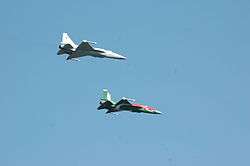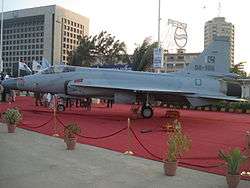Pakistan Aeronautical Complex
The Pakistan Aeronautical Complex (PAC) (Urdu: پاکستان ایروناٹیکل کمپلیکس) is an aircraft manufacturer and supplier based in Pakistan.
 Official logo of Pakistan Aeronautical Complex | |
Native name | پاکستان ایروناٹیکل کمپلیکس |
|---|---|
| State-owned company | |
| Industry | |
| Founded | Kamra, Punjab, Pakistan 1971 |
| Headquarters | , |
Area served | Worldwide |
Key people | Air Marshal Syed Noman Ali Chairman |
| Products | Product list
|
Production output | Military Aircraft |
| Services | Aircraft maintenance Aircraft MLU systems Aircraft design, R&D |
| Owner | Ministry of Defence Production (Primary owner; other ownership) |
| Parent | Pakistan Air Force |
| Divisions | Divisions
|
| Subsidiaries | Air Weapons Complex |
| Website | www.pac.org.pk |
The PAC operates as a corporation that supplies the Pakistani military and private sector as an aerospace defence contractor that produces aerial systems.[1]
Founded in 1971 by the Pakistan Air Force (PAF), the PAC designs, develops, and builds aircraft and avionics systems for the Inter–Services of the country; it also provides its services for civilian aircraft.[2] In addition, the PAC performs local maintenance and works on the aircraft MLU systems of foreign-built military and civilian aircraft. It is solely owned by the PAF and its corporate interests & its corporate appointments are directly made by the Chief of Air Staff from the Air HQ.[2]
Mainly focusing on avionics, aviation, and high-tech electronics, the PAC also manufactures military systems for the Pakistan Army and Navy.[3] Many of these products are specially suited for the Pakistan Armed Forces needs, while others are also marketed to foreign export. While it collaborated with several countries’ corporate organizations, the PAC often jointly works with the Turkish TAI and the Chinese CATIC.[4] Its aircraft have been exported to Myanmar, Nigeria, Qatar, Saudi Arabia and the United Arab Emirates.[5][6][3]
Operations
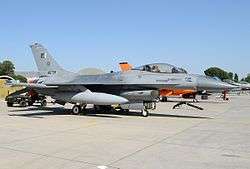
Since 1947, the Pakistan Air Force operated largely dependent on foreign suppliers, fighter jets and aircraft had to be sent abroad for desired inspection, development, and to produce parts to maintain the fighter aircraft in service, causing the downsizing of the air force.[1]
After consultation from the PAF's commanders at AHQ at the Pindi Cantt, the Pakistan Aeronautical Complex (PAC) was established in 1973 in Kamra with Aircraft Rebuild Factory first being functional.[7][8] PAC was established by the Pakistan Air Force (PAF) as part of the new defence policy introduced in 1972; the PAC represents wide range of corporate revenue of the air force while fulfilling the national security needs of the country.[1] The Pakistan Aeronautical Complex started with three main Ministry of Defence projects designated P-721, P-741 and P-751.[7] The first two digits show the year of project approval and launch, the third digit is a serial designator.[7]
Since 1980s–90s, PAC functions include licensed-built Mirage-III, Mirage-5, and the F-16s as well as building the F100 engines for the F-16s under license from Pratt & Whitney.[9]
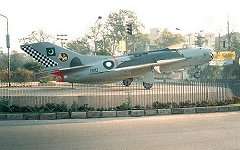
Aircraft Rebuild Factory
Aircraft Rebuild Factory (ARF), formerly known as F-6 Rebuild Factory (F-6RF) and P-721, is primarily dedicated to the overhaul and parts manufacture of Chinese aircraft in service with the Pakistan Air force (PAF). The factory is capable of overhauling and parts manufacturing for the Shenyang F-6 (now retired by the PAF), Nanchang A-5 (also retired by the PAF) and F-7 combat aircraft, as well as the Shenyang FT-5 and FT-6 jet trainer aircraft. ARF is also capable of manufacturing drop tanks and harnesses of aircraft.
Mirage Rebuild Factory
The Mirage Rebuild Factory (MRF), formerly known as P-741, is dedicated to the overhaul of French origin military aircraft in service with the Pakistan Air Force (PAF), the Dassault Mirage III and Mirage V combat aircraft. Overhaul and manufacturing services were used by other countries with French Mirage aircraft in service. The Mirage III and Mirage 5 are under license and built at the PAC factory. This factory also grew to service and overhaul the Pratt & Whitney F100 turbofan engines belonging to the F-16 Fighting Falcon combat aircraft of the PAF. Due to lack of budget for replacing outdated aircraft, the MRF was devoted to domestically overhauling them, which according to claims, saved the country billions of dollars.[10]
Project ROSE
Project ROSE (Retrofit Of Strike Element[11]), was a program initiated by the Pakistan Air Force (PAF) Pakistan Aeronautical Complex for the upgrades of the military avionics and electronics system of its aging Dassault Aviation– built Mirage fighter jets.[12] The program focused on modernization of military avionics and on-board computer system of Mirage IIIE and the Mirage V supplied by Pakistani Margella Electronics, French SAGEM and the Italian SELEX consortiums, as part of the program.[13]
Conceived in 1992 by the Pakistan Air Force, the program started in 1995 on main considerations of retiring the A–5 Fantan from active service.[11] The Pakistan Air Force which already was operating Dassalt Mirage-3s and Dassalt Mirage-5s began its procurement of second-hand Mirage fighters from Australia, Lebanon, Libya, and Spain at the price range within the MoD's fund.[14] Over 90% of the aircraft were retrofitted at the Aeronautical Complex in Kamra; few were upgraded in France.[14] From 1996–2000, several Mirage IIIE and Mirage 5 were bought from the other countries and were upgraded under this program at the Pakistan Aeronautical Complex.[14] In this project the avionics of the aircraft were increased, in-flight refueling was added, due to this the range and combat radius of the fighter jet was increased, new grifo fire control radars having about 75 km range were introduced which gave the aircraft capability to fire BVR missiles if needed, the metallurgy of aircraft was overhauled and service life was increased, the capability to do take off and landing from motorway was also added, after the Rose-3 upgrading the locally manufactured standoff weapons like H-4 SOW bombs, H-2 SOW bombs, Takbir glide bomb , Stealth nuclear cruise missiles such as Ra'ad MK-1 and Ra'ad Mk-2 were added in the weapon package of the aircraft. Further considerations for upgrades were recommended but the program was terminated due to increasingly combined costs of the spare parts and the conditions of the second–hand airframes of the Mirage IIIE and Mirage V at the time of their procurement from various countries.[14]
It is currently expected for all of ROSE upgraded Mirage fighters jets to be remain in the combat service with Pakistan Air Force beyond 2020 in specialized Tactical Attack roles. They are expected to be replaced by JF–17 Thunder (Block-3, Block-4 and Block-5) or additional F-16s or 5th generation stealth fighter coming out Project Azm.
Aircraft Manufacturing Factory
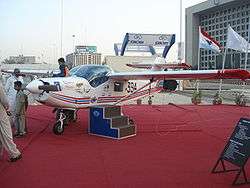
Aircraft Manufacturing Factory (AMF), formerly known as P-751, is dedicated to heavy military aircraft manufacturing. The MFI-17 Mushshak basic trainer aircraft built under license for use by the Pakistan Air Force (PAF) and Pakistan Army aviation wing. This factory project managed the aircraft modification and development venture that resulted in the MFI-395 Super Mushshak basic trainer, based on the MFI-17 Mushshak. Development of the K-8 Karakorum (also known as Hongdu JL-8) intermediate/advanced jet trainer was done in co-operation with Hongdu Aviation Industry Group of China, with AMF manufacturing parts for the aircraft. The JF-17 multi-role combat aircraft (also known as FC-1), a joint project between China and Pakistan, is now being manufactured by AMF. The MFI-17, MFI-395, K-8 and JF-17 are now in service with the (PAF). AMF also designs and manufactures unmanned aerial vehicles for uses such as target practice.
Manufacture of sub-assemblies for the JF-17 light-weight multi-role fighter began on 22 January 2008, while serial production of the fighter began on 30 June 2009.
On 20 August 2009 the PAF announced that it would begin production of its own unmanned aerial vehicles in collaboration with Italian company Selex Galileo. Production of the UAV, named Falco, was to begin soon.[15] An earlier opportunity to manufacture a fighter aircraft was lost when the Pakistan Air Force abandoned Project Sabre II in 1987, a joint effort by Pakistan, China and Grumman Aerospace that would have seen AMF manufacturing a re-designed Chengdu F-7 variant.
Avionics Production Factory (APF)
Avionics production Factory (APF), formerly known as Kamra Avionics and Radar Factory (KARF) was initiated as Radar Maintenance Centre (RMC) in 1983 to overhaul and rebuild ground-based radar systems. In 1989, RMC was expanded to become Kamra Radar & Avionics Factory (KARF). APF has the facilities to assemble and overhaul airborne as well as ground-based radar systems, electronics and avionics. the ISO 9002 certified facility among PAC, the factory was involved in upgrading the Pakistan Air Force (PAF) Chengdu F-7P interceptor fleet by replacing the original Italian built FIAR Grifo-7 radar with the more capable FIAR Grifo-7 mk-II radar, which was assembled under licence by APF. More recently, radar production involved the license assembly of the latest upgrade variant of the FIAR Grifo-7, the Grifo-7MG radar, which arms the Chengdu F-7PG combat aircraft of the PAF. In mid-2009 it was reported that APF personnel had completed training on printed circuit board assembly machines supplied by US company APS Novastar, which would be used to make circuit boards for combat aircraft avionics.[16]
As PAC's capabilities become competitive in the region, commercial ventures from national and international companies are also being undertaken.
Project Azm
On 7 July 2017 the Pakistan Air Force announced the development of a fifth-generation fighter jet technology's, a stealth medium-altitude long-endurance unmanned aerial vehicle (MALE UAV) and munitions and a smart longer range surface to air missile systems SAM missile systems under the banner of Project Azm (resolve or determination). Pakistani public and private sectors are jointly working on the development of Next generation stealth fighter aircraft (PAC PF-X) whose first flight is expected in 2030, moreover work has also begun for the development of stealth MALE-UCAV ZF-1 Viper. The information about this Multirole Stealth drone was first revealed at International Defence Exhibition and Seminar held at Karachi, this UAV will have both air-to-air and air-to-surface capabilities, it will have a maximum takeoff weigh of 16000 kg and a flight ceiling of 9150m and its speed will be Mach 0.8. Certain rumours were being spread that China might be helping Pakistan in this project, but Pakistan's Air Marshal Shahid Latif (retired), who played a key role in the development of PAC JF-17 Thunder, nullified the rumours by saying that although they still have an option to go for joint collaboration with China, but PAF had gained as much experience and knowledge after the successful development of PAC JF-17 Thunder that PAC engineers are experienced enough to begin development of a next generation fighter on their own.[17][18][19][20][21] Air Chief Marshal Sohail Aman stated that the design phase for the MALE UAV was in its final stages.[17][21] Pakistan Air Force showcased the conceptual design of a future stealth aircraft on the tail of the PAF C-130 at the Royal International Air Tattoo (RIAT) 2019. However, there's no official statement regarding this by PAF.[22]
As per the yearbook of the Pakistan Ministry of Defence Production (MoDP) for the year 2017-2018, the Aviation Research, Innovation and Development (AvRID) Secretariat has finalized the first of the four conceptual design stage cycles for the development of the Pakistan Air Force’s Fifth-Generation Fighter Aircraft (FGFA) program.[22]
Products
Aircraft
- JF-17 Thunder - produced with Chengdu Aerospace Corporation of China[23]
- Chengdu F-7P - improved version of Chengdu J-7 of China
- K-8 Karakorum - co-production with Hongdu Aviation Industry Group of China
- Super Mushshak - upgraded variant of MFI-17 Mushshak
- Super Mushshak LCA - light combat variant of Super Mushshak
- MFI-17 Mushshak - upgraded variant of PAC MFI-15 Safari
- PAC MFI-15 Safari - licensed copy of Saab Safari of Sweden.
Unmanned aerial vehicles (UAV)
- Ababeel Aerial Drone – A small arms target designed for target practice use by operators of small arms, machine guns. Also used to train operators for the larger and faster Baaz Aerial Drone. Can be very effective for recce missions.[24]
- Baaz Aerial Drone – A recoverable aerial target designed for use with air defence guns and surface-to-air missile (SAM) systems. It has a very high rate of accuracy[25]
- Galileo Falco – A surveillance UAV, production began in August 2009 under license of Selex ES of Italy.[26][27]
Services
- Aircraft Manufacturing
- Airborne Systems
- Aircraft Overhaul
- Avionics Overhaul
- Engine Overhaul
- Radar Overhaul
- Component Overhaul
References
- "History". PAC. Retrieved 28 November 2014.
- "Introduction". PAC. Retrieved 28 November 2014.
- "Customers". PAC. Retrieved 28 November 2014.
- "Collaboration". PAC. Retrieved 28 November 2014.
- "Nigeria to buy 10 Super Mushshak from Pakistan". The Express Tribune. 22 October 2016. Retrieved 22 October 2016.
- "Qatar to buy Super Mushshak". The Express Tribune. 24 June 2016. Retrieved 22 October 2016.
- Singh, RSN (2005). Asian strategic and military perspective. New Delhi: Lancer Publishers & Distributors. ISBN 817062245-X. Retrieved 23 December 2014.
- Singh, R.S.N. (2008). The military factor in Pakistan. New Delhi: Frankfort, IL. ISBN 0-98153789-8. Retrieved 23 December 2014.
- "Mırage Rebuıld Factory". PAC. Retrieved 23 December 2014.
- "Thrifty at 50: How the Pakistan Air Force keeps ageing Mirages flying". Dawn. 29 April 2018 – via AFP.
- "Project ROSE". Grand Strategy. 22 June 2013. Archived from the original on 24 November 2014. Retrieved 24 November 2014.
- Pike, John. "Mirage-III and Mirage 5". Global Security. Retrieved 24 November 2014.
- Sheikh, Rashid (2001). The story of the Pakistan Air Force, 1988–1998 : a battle against odds. Pakistan: Shaheen Foundation. p. 432. ISBN 978-969855300-5.
- "Mirage-III/Mirage-5". PAF Falcon. Archived from the original on 24 September 2015. Retrieved 24 November 2014.
- Malik, Sajjad (21 August 2009). "Pak version of drones 'whirrs' into production". Daily Times. Retrieved 21 August 2009.
- "Novastar on circuit in Pakistan" (PDF). Mac alliance. Archived from the original (PDF) on 29 December 2009. Retrieved 1 February 2010.
- Khan, Bilal (6 July 2017). "Pakistan Announces 5th-Gen Fighter and Medium-Altitude Long-Endurance UAV Programs". QUWA. Retrieved 9 July 2017.
- "PAF establishes Aviation City at Aeronautical Complex Kamra". The Nation. 6 July 2017. Retrieved 9 July 2017.
- "Groundbreaking ceremony of Aviation City held in Kamra". The News International. 6 July 2017. Retrieved 10 July 2017.
- Khan, Bilal (9 July 2017). "Reviewing Pakistan's Goals For The Kamra Aviation City Initiative". QUWA Defence News and Analysis Group. Retrieved 10 July 2017.
- "Pakistan To Develop Long Endurance Attack Drone". Defence World. 8 July 2017. Retrieved 10 July 2017.
- "Pakıstan makes progress on next-gen fıghter program". Quwa. Retrieved 16 November 2019.
- "JF-17 Thunder Aircraft". Pakistan Aeronautical Complex. Retrieved 15 December 2017.
- Archived 14 May 2009 at the Wayback Machine
- Archived 14 May 2009 at the Wayback Machine
- "Pakistan Air Force Begins Production of Falco UAV". Airforce Technology. Retrieved 3 May 2013.
- "Pakistan to begin co-production of Falco UAV". Flightglobal.com. 26 August 2009. Retrieved 3 May 2013.
- Brummitt, Chris. "Guns and Androids: Pakistan Air Force Making iPads." Associated Press. 17 February 2012.
- "eBook 1". Archived from the original on 26 May 2013. Retrieved 27 February 2012.
- "nBook 1". Archived from the original on 3 June 2013. Retrieved 27 February 2012.
